River Freshwater Contribution in Operational Ocean Models along the European Atlantic Façade: Impact of a New River Discharge Forcing Data on the CMEMS IBI Regional Model Solution
Abstract
1. Introduction
2. Materials and Methods
2.1. Description of Study Domain: In-Situ Observed Salinity Products
2.2. Description of the New River Freshwater LAMBDA Database
2.3. The CMEMS IBI Salinity Model Product
2.4. Description of the IBI Model Sensitivity Tests Performed Using LAMBDA Product as Forcing
3. Results
3.1. How Does the Operational CMEMS IBI Forecast Model Reproduce Salinity Fields?
- 22–28 February 2018: False alarm. IBI showed a SSS drop (more than 1 PSU), not so intense in the observed data.
- 20–30 March 2018: Hit. Both IBI and observed data exhibited a SSS drop (of more than 2 PSUs), with a very similar time evolution.
- 21 April–1 May 2018: Hit. Both IBI and Silleiro Buoy observation exhibited a SSS drop (about 2 PSUs), and the model overestimates the observed decrease.
- 10–14 May 2018: False alarm. IBI showed a non-observed SSS drop (around 1 PSU).
- 30 May–10 June 2018: False alarm. IBI showed a SSS drop around 1 PSU.
- 1–9 January 2019: Hit. Both IBI and observed data exhibited a moderate SSS drop of 0.5 PSU and a steady recovery during the following days.
- 13–17 February 2019: Miss. Observed drop of 0.5 PSU not reproduced by IBI.
- 25–28 February 2019: Hit. IBI clearly overestimated the observed SSS drop.
- 20–26 March 2019: Hit. IBI clearly overestimated the observed SSS drop.
3.2. IBI Model Sensitivity to Changes in Freshwater Coastal and River Forcing
3.2.1. BISCA Region
3.2.2. WISHE Region
3.2.3. CADIZ Region
4. Discussion
4.1. How Are the Proposed Ocean Model Scenarios Configured?
4.2. Is the IBI Model Application (Used in the Scenarios) Suitable to Simulate Salinity Field in the Study Area?
4.3. Model Scenario Validation: Are Available In-Situ Observations Adequate to Evaluate Model Sensitivity?
4.4. How Different Are the River Flow Estimations Used as Forcing in the Ocean Model Scenarios?
4.5. What Are the Major Impacts in Salinity Associated to the Proposed Changes in Freshwater Forcing?
4.6. What Are the Regional Impacts in the Three Areas of Interest?
4.7. Impacts in the Gulf of Biscay
4.8. Impacts in the Western Iberian Shelf
4.9. Impacts in the Gulf of Cadiz
5. Conclusions and Future Research Directions
Author Contributions
Funding
Institutional Review Board Statement
Informed Consent Statement
Data Availability Statement
Acknowledgments
Conflicts of Interest
References
- Dai, A.; Trenberth, K.E. Estimates of Freshwater Discharge from Continents: Latitudinal and Seasonal Variations. J. Hydrometeorol. 2002, 3, 660–687. [Google Scholar] [CrossRef]
- Garvine, R.W.; Whitney, M.M. An estuarine box model of freshwater delivery to the coastal ocean for use in climate models. J. Mar. Res. 2006, 64, 173–194. [Google Scholar] [CrossRef]
- Fong, D.A.; Geyer, W.R. The Alongshore Transport of Freshwater in a Surface-Trapped River Plume. J. Phys. Oceanogr. 2002, 32, 957–972. [Google Scholar] [CrossRef]
- Simpson, J.H. Physical processes in the ROFI regime. J. Mar. Syst. 1997, 12, 3–15. [Google Scholar] [CrossRef]
- Otero, P.; Ruiz-Villarreal, M.; Peliz, A. Variability of river plumes off Northwest Iberia in response to wind events. J. Mar. Syst. 2008. [Google Scholar] [CrossRef]
- Kourafalou, V.H.; Androulidakis, S.Y. Influence of Mississippi River induced circulation on the Deepwater Horizon oil spill transport. J. Geophys. Res. 2013, 118, 3823–3842. [Google Scholar] [CrossRef]
- Banas, N.S.; MacCready, P.; Hickey, B.M. The Columbia River plume as cross-shelf exporter and along-coast barrier. Cont. Shelf Res. 2009, 29, 292–301. [Google Scholar] [CrossRef]
- Santos, A.M.P.; Chícharo, A.; Dos Santos, A.; Moita, T.; Oliveira, P.B.; Peliz, Á.; Ré, P. Physical–biological interactions in the life history of small pelagic fish in the Western Iberia Upwelling Ecosystem. Prog. Oceanogr. 2007, 74, 192–209. [Google Scholar] [CrossRef]
- Zuo, H.; de Boisséson, E.; Zsoter, E.; Harrigan, S.; de Rosnay, P.; Wetterhall, F.; Prudhomme, C. Benefits of dynamically modelled river discharge input for ocean and coupled atmosphere-land-ocean systems. In Proceedings of the EGU General Assembly, Vienna, Austria, 4–8 May 2020. [Google Scholar] [CrossRef]
- Bourdalle-Badie, R.; Treguier, A.M. Mercator-Ocean Report. A Climatology of Runoff for the Global Ocean-Ice Model ORCA025; Technical Report MOO-RP-425-365-MER; Mercator Ocean: Toulouse, France, 2006. [Google Scholar]
- Dai, A.; Qian, T.; Trenberth, K.E.; Milliman, J.D. Changes in Continental Freshwater Discharge from 1948 to 2004. J. Clim. 2008, 22, 2773–2792. [Google Scholar] [CrossRef]
- Global Runoff Data Centre. Available online: https://www.bafg.de/GRDC/EN/Home/homepage_node.html (accessed on 2 June 2020).
- Harrigan, S.; Zsoter, E.; Alfieri, L.; Prudhomme, C.; Salamon, P.; Wetterhall, F.; Barnard, C.; Cloke, H.; Pappenberger, F. GloFAS-ERA5 operational global river discharge reanalysis 1979–present. Earth Syst. Sci. Data Discuss 2020. [Google Scholar] [CrossRef]
- Kourafalou, V.H.; de Mey, P.; Staneva, J.; Ayoub, N.; Barth, A.; Chao, Y.; Cirano, M.; Fiechter, J.; Herzfeld, M.; Kurapov, A.; et al. Coastal Ocean Forecasting: Science foundation and user benefits. J. Oper. Oceanogr. 2015, 8, 147–167. [Google Scholar] [CrossRef]
- Campuzano, F.; Brito, D.; Juliano, M.; Fernandes, R.; de Pablo, H.; Neves, R. Coupling watersheds, estuaries and regional ocean through numerical modelling for western iberia: A novel methodology. Ocean Dyn. 2016, 66, 1745–1756. [Google Scholar] [CrossRef]
- Zheng, L.; Weisberg, R.H. Modelling the West Florida Coastal Ocean by Downscaling from the Deep Ocean, Across the Continental Shelf and into the Estuaries. Ocean Model. 2012, 48, 10–29. [Google Scholar] [CrossRef]
- Lorente, P.; Sotillo, M.; Amo-Baladrón, A.; Aznar, R.; Levier, B.; Sánchez-Garrido, J.C.; Sammartino, S.; de Pascual-Collar, Á.; Reffray, G.; Toledano, C.; et al. Skill assessment of global, regional, and coastal circulation forecast models: Evaluating the benefits of dynamical downscaling in IBI (Iberia–Biscay–Ireland) surface waters. Ocean Sci. 2019, 15, 967–996. [Google Scholar] [CrossRef]
- Sotillo, M.G.; Cerralbo, P.; Lorente, P.; Grifoll, M.; Espino, M.; Sanchez-Arcilla, A.; Álvarez-Fanjul, E. Coastal ocean forecasting in Spanish ports: The SAMOA operational service. J. Oper. Oceanogr. 2019, 13, 37–54. [Google Scholar] [CrossRef]
- EU Copernicus Marine Environment Monitoring Service (CMEMS). Available online: https://marine.copernicus.eu/ (accessed on 3 September 2020).
- Sotillo, M.G.; Cailleau, S.; Lorente, P.; Levier, B.; Aznar, R.; Reffray, G.; Amo-Baladrón, A.; Alvarez-Fanjul, E. The MyOcean IBI ocean forecast and reanalysis systems: Operational products and roadmap to the future Copernicus service. J. Oper. Oceanogr. 2015, 8, 63–79. [Google Scholar] [CrossRef]
- Le Traon, P.Y.; Reppucci, A.; Fanjul, E.A.; Aouf, L.; Behrens, A.; Belmonte, M.; Bentamy, A.; Bertino, L.; Brando, V.E.; Kreiner, M.B.; et al. From observation to information and users: The Copernicus Marine service perspective. Front. Mar. Sci. 2019, 6, 234. [Google Scholar] [CrossRef]
- Capet, A.; Fernández, V.; She, J.; Dabrowski, T.; Umgiesser, G.; Staneva, J.; Mészáros, L.; Campuzano, F.; Ursella, L.; Nolan, G.; et al. Operational Modeling Capacity in European Seas—An EuroGOOS Perspective and Recommendations for Improvement. Front. Mar. Sci. 2020, 7, 129. [Google Scholar] [CrossRef]
- MyCoast Project (EU INTERREG Atlantic Area Transnational Cooperation Programme). Available online: http://www.mycoast-project.org/ (accessed on 3 September 2020).
- Matulka, A.; Lorente, P.; Sotillo, M.G.; Campuzano, F.; Sobrinho, J.; Taboada, J.; Melo, P.; Ferrer, L.; Robert, M.; Dabrowski, T.; et al. MyCOAST Regional & Coastal Ocean Models. In Proceedings of the 1st MyCOAST Regional Workshop Southeastern Bay of Biscay, San Sebastian, Spain, 11–13 November 2019. [Google Scholar]
- CMEMS STAC. Copernicus Marine Environment Monitoring Service (CMEMS) Service Evolution Strategy: R&D priorities. Version 3. 2017. Available online: http://marine.copernicus.eu/wp-content/uploads/2017/06/CMEMS-Service_evolution_strategy_RD_priorities_V3-final.pdf (accessed on 3 September 2020).
- Bronco Project. CMEMS Service Evolution Project. Available online: https://www.mercator-ocean.fr/en/portfolio/bronco-2/ (accessed on 3 September 2020).
- Lambda Project. CMEMS Service Evolution Project. Available online: http://www.cmems-lambda.eu/ (accessed on 6 April 2021).
- Pingree, R.D.; Le Cann, B. A shallow meddy (a smeddy) from the secondary Mediterranean salinity maximum. J. Geophys. Res. Ocean. 1993, 98, 20169–20185. [Google Scholar] [CrossRef]
- Jia, Y. Formation of an Azores Current Due to Mediterranean Overflow in a Modeling Study of the North Atlantic. J. Phys. Oceanogr. 2000, 30, 2342–2358. [Google Scholar] [CrossRef]
- Carracedo, L.; Gilcoto, M.; Mercier, H.; Pérez, F. Seasonal dynamics in the Azores–Gibraltar Strait region: A climatologically-based study. Prog. Oceanogr. 2014, 122, 116–130. [Google Scholar] [CrossRef]
- Sánchez, R.F.; Relvas, P. Spring–summer climatological circulation in the upper layer in the region of Cape St. Vincent, Southwest Portugal. ICES J. Mar. Sci. 2003, 60, 1232–1250. [Google Scholar] [CrossRef]
- Folkard, A.M.; Davies, P.A.; Fiúza, A.F.G.; Ambar, I. Remotely sensed sea surface thermal patterns in the Gulf of Cadiz and the Strait of Gibraltar: Variability, correlations, and relationships with the surface wind field. J. Geophys. Res. Ocean. 1997, 102, 5669–5683. [Google Scholar] [CrossRef]
- Lobo, F.J.; Le Roy, P.; Mendes, I.; Sahabi, M.; Chiocci, F.L.; Chivas, A.R. (Eds.) Continental Shelves of the World: Their Evolution During the Last Glacio-Eustatic Cycle. 9. The Gulf of Cádiz Continental Shelves; The Geological Society of London: London, UK, 2014. [Google Scholar] [CrossRef]
- Peliz, Á.; Santos, A.M.P.; Oliveira, P.B.; Dubert, J. Extreme cross-shelf transport induced by eddy interactions southwest of Iberia in winter 2001. Geophys. Res. Lett. 2004, 31. [Google Scholar] [CrossRef]
- Lobo, F.; Sánchez, R.; González, R.; Dias, J.; Hernández-Molina, F.; Fernández-Salas, L.; del Río, V.D.; Mendes, I. Contrasting styles of the Holocene highstand sedimentation and sediment dispersal systems in the northern shelf of the Gulf of Cadiz. Cont. Shelf Res. 2004, 24, 461–482. [Google Scholar] [CrossRef]
- González, A.F.; Otero, J.; Guerra, A.; Prego, R.; Rocha, F.J.; Dale, A.W. Distribution of common octopus and common squid paralarvae in a wind-driven upwelling area (Ria of Vigo, northwestern Spain). J. Plankton Res. 2005, 27, 271–277. [Google Scholar] [CrossRef]
- Haynes, R.; Barton, E.D.; Pilling, I. Development, Persistence, and Variability of Upwelling Filaments off the Atlantic Coast of the Iberian Peninsula. J. Geophys. Res. 1993, 98, 22681–22692. [Google Scholar] [CrossRef]
- Peliz, A.; Dubert, J.; Santos, A.M.P.; Oliveira, P.B.; Le Cann, B. Winter upper ocean circulation in the Western Iberian Basin—Fronts, Eddies and Poleward Flows: An overview. Deep Sea Res. 2005, 52, 621–646. [Google Scholar] [CrossRef]
- Kouttsikopoulos, C. Physical processes and hydrological structures related to the Bay of Biscay anchovy. Sci. Mar. 1996, 60, 9–19. [Google Scholar]
- Kersalé, M.; Marié, L.; Le Cann, B.; Serpette, A.; Lathuilière, C.; Le Boyer, A.; Rubio, A.; Lazure, P. Poleward along-shore current pulses on the inner shelf of the Bay of Biscay. Estuar. Coast. Shelf Sci. 2016, 179, 155–171. [Google Scholar] [CrossRef]
- Batifoulier, F.; Lazure, P.; Bonneton, P. Poleward coastal jets induced by westerlies in the Bay of Biscay. J. Geophys. Res. Ocean. 2012, 117. [Google Scholar] [CrossRef]
- Solabarrieta, L.; Rubio, A.; Cárdenas, M.; Castanedo, S.; Esnaola, G.; Méndez, F.; Medina, R.; Ferrer, L. Probabilistic relationships between wind and surface water circulation patterns in the SE of Bay of Biscay. Ocean Dyn. 2015, 65, 1289–1303. [Google Scholar] [CrossRef]
- Charria, G.; Theethen, S.; Vandermeirsch, F.; Yelekçi, O.; Audriffren, N. Interannual evolution of (sub)mesoscale dynamics in the Bay of Biscay. Ocean Sci. 2017, 13, 777–797. [Google Scholar] [CrossRef]
- Reverdin, G.; Marié, L.; Lazure, P.; d’Ovidio, F.; Boutin, J.; Testor, P.; Martin, N.; Lourenco, A.; Gaillard, F.; Lavin, A.; et al. Freshwater from the Bay of Biscay shelves in 2009. J. Mar. Syst. 2013, 109–110, S134–S143. [Google Scholar] [CrossRef]
- Castaing, P.; Froidefond, J.; Lazure, P.; Weber, O.; Prud’homme, R.; Jouanneau, J. Relationship between hydrology and seasonal distribution of suspended sediments on the continental shelf of the Bay of Biscay. Deep Sea Res. Part II Top. Stud. Oceanogr. 1999, 46, 1979–2001. [Google Scholar] [CrossRef]
- Valencia, V.; Franco, J.; Borja, A.; Fontan, A.; Borja, A.; Collins, M. (Eds.) Oceanography and Marine Environment of the Basque Country Hydrography of the Southeastern Bay of Biscay; Elsevier: Amsterdam, The Netherlands, 2004; Chapter 7; pp. 159–194. [Google Scholar]
- Ferrer, L.; Fontán, A.; Mader, J.; Chust, G.; Gonzáles, M.; Valencia, V.; Uriarte, A.; Collins, M.B. Low-salinity plumes in the oceanic region of the Basque Country. Cont. Shelf Res. 2009, 29, 970–984. [Google Scholar] [CrossRef]
- Copernicus Marine In-Situ Tac Data Management Team. Product User Manual for Multiparameter Copernicus In Situ TAC NRT Product (PUM). 2020. Available online: https://archimer.ifremer.fr/doc/00324/43494/ (accessed on 8 April 2021).
- Venâncio, A.; Montero, P.; Costa, P.; Regueiro, S.; Brands, S.; Taboada, J. An Integrated Perspective of the Operational Forecasting System in Rías Baixas (Galicia, Spain) with Observational Data and End-Users. In Computational Science—ICCS 2019, Lecture Notes in Computer Science; Springer: Cham, Switzerland, 2019; Volume 11539, pp. 229–239. ISBN 978-3-030-22746-3. [Google Scholar]
- Losada, D.E.; Montero, P.; Brea, D.; Allen-Perkins, S.; Vila, B. Clustering Hydrographic Conditions in Galician Estuaries. In Computational Science—ICCS 2019, Lecture Notes in Computer Science; Springer: Cham, Switzerland, 2019; Volume 11539, pp. 346–360. ISBN 978-3-030-22746-3. [Google Scholar]
- Szekely, T.; Bezaud, M.; Pouliquen, S.; Reverdin, G.; Charria, G. CORA-IBI, Coriolis Ocean Dataset for Reanalysis for the Ireland-Biscay-Iberia region. SEANOE 2017. [Google Scholar] [CrossRef]
- Leblond By, E.; Lazure, P.; Laurans, M.; Rioual, C.; Woerther, P.; Quemener, L.; Berthou, P. RECOPESCA: A new example of participative approach to colletc in-situ environmental and fisheries data. Jt. Coriolis Mercator Ocean Q. Newsl. 2010, 37, 40–55. [Google Scholar]
- Brito, D.; Campuzano, F.J.; Sobrinho, J.; Fernandes, R.; Neves, R. Integrating operational watershed and coastal models for the Iberian Coast: Watershed model implementation—A first approach. Estuar. Coast. Shelf Sci. 2015, 167 Pt A, 138–146. [Google Scholar] [CrossRef]
- Neves, R. The MOHID concept. In Ocean Modelling for Coastal Management—Case Studies with MOHID; Mateus, M., Neves, R., Eds.; IST Press: Lisbon, Portugal, 2013; pp. 1–11. [Google Scholar]
- Campuzano, F.; Santos, F.; Ramos de Oliveira, A.I.; Simionesei, L.; Fernandes, R.; Brito, D.; Olmedo, E.; Turiel, A.; Alba, M.; Novellino, A.; et al. Framework for improving land boundary conditions in regional ocean products. In Proceedings of the EGU General Assembly, Vienna, Austria, 4–8 May 2020. [Google Scholar] [CrossRef]
- Amo, A.; Reffray, G.; Sotillo, M.G.; Aznar, R.; Guihou, K. Product User Manual (PUM) for Atlantic-Iberian Biscay Irish-Ocean Physics Analysis and Forecasting Product: IBI_ANALYSIS_FORECAST_PHYS_005_0012020. Available online: https://resources.marine.copernicus.eu/documents/PUM/CMEMS-IBI-PUM-005-001.pdf (accessed on 3 September 2020).
- Madec, G. NEMO Ocean General Circulation Model, Reference Manual, Internal Report; LODYC/IPSL: Paris, France, 2008. [Google Scholar]
- Lellouche, J.-M.; Le Galloudec, O.; Drévillon, M.; Régnier, C.; Greiner, E.; Garric, G.; Ferry, N.; Desportes, C.; Testut, C.-E.; Bricaud, C.; et al. Evalution of global monotoring and forecasting systems at Mercator Océan. Ocean Sci. 2013, 9, 57–81. [Google Scholar] [CrossRef]
- Chune, S.L.; Nouel, L.; Fernandez, E.; Derval, C.; Tressol, M.; Dussurget, R. Product User Manual (PUM) for GLOBAL Ocean Sea Physical Analysis and Forecasting Products GLOBAL_ANALYSIS_FORECAST_PHY_001_024. 2020. Available online: https://resources.marine.copernicus.eu/documents/PUM/CMEMS-GLO-PUM-001-024.pdf (accessed on 27 October 2020).
- Carrere, L.; Lyard, F.; Cancet, M.; Guillot, A.; Picot, N. FES 2014, a new tidal model—Validation results and perspectives for 655 improvements. In Proceedings of the ESA Living Planet Conference, Prague, Czech Republic, 9–13 May 2016. [Google Scholar]
- Aznar, R.; Sotillo, M.G.; Cailleau, S.; Lorente, P.; Levier, B.; Amo-Baladrón, A.; Reffray, G.; Álvarez-Fanjul, E. Strengths and weaknesses of the CMEMS forecasted and reanalyzed solutions for the Iberia–biscay–Ireland (IBI) waters. J. Mar. Syst. 2016, 159, 1–14. [Google Scholar] [CrossRef]
- Lorente, P.; Sotillo, M.G.; Amo-Baladrón, A.; Aznar, R.; Levier, B.; Aouf, L.; Dabrowski, T.; de Pascual, Á.; Dalphinet, G.R.A.; Toledano, C.; et al. The NARVAL Software Toolbox in Support of Ocean Models Skill Assessment at Regional and Coastal Scales. In Computational Science—ICCS 2019, Lecture Notes in Computer Science; Springer: Cham, Switzerland, 2019; Volume 11539, pp. 315–328. ISBN 978-3-030-22746-3. [Google Scholar] [CrossRef]
- Olmedo, E.; Martínez, J.; Turiel, A.; Ballabrera-Poy, J.; Portabella, M. Debiased non-Bayesian retrieval: A novel approach to SMOS Sea Surface Salinity. Remote Sens. Environ. 2017, 193, 103–126. [Google Scholar] [CrossRef]
- Grodsky, S.; Reverdin, G.; Carton, J.; Coles, V. Year to year salinity changes in the Amazon plume: Contrasting 2011 and 2012 Aquarius/SACD and SMOS satellite data. Remote Sens. Environ. 2014, 140, 14–22. [Google Scholar] [CrossRef]
- Fournier, S.; Lee, T.; Gierach, M. Seasonal and Interannual variations of sea surface salinity associated with Mississippi River plume observed by SMOS and Aquarius. Remote Sens. Environ. 2016, 180, 431–439. [Google Scholar] [CrossRef]
- Olmedo, E.; González-Haro, C.; Hoareau, N.; Umbert, N.; González-Gambau, V.; Martínez, J.; Gabarró, C.; Turiel, A. Nine years of SMOS Sea Surface Salinity global maps at the Barcelona Expert Center. Earth Syst. Sci. Data Discuss. 2020. [Google Scholar] [CrossRef]
- Olmedo, E.; González-Gambau, V.; Martínez, J.; González-Haro, C.; Turiel, A.; Portabella, M.; Arias, M.; Sabia, R.; Oliva, R.; Corbella, I. Characterization and Correction of the Latitudinal and Seasonal Bias in BEC SMOS Sea Surface Salinity Maps. In Proceedings of the 2019 IEEE International Geoscience and Remote Sensing Symposium (IGARSS’19), Yokohama, Japan, 28 July–2 August 2019. [Google Scholar] [CrossRef]
- Campuzano, F. Coupling Watersheds, Estuaries and Regional Seas through Numerical Modelling for Western Iberia. Ph.D. Thesis, Instituto Superior Técnico, Universidade de Lisboa, Lisboa, Portugal, 2018. Available online: http://www.mohid.com/PublicData/products/Thesis/PhD_Francisco_Campuzano.pdf (accessed on 6 April 2021).
- Sotillo, M.G.; Levier, B.; Lorente, P.; Guihou, K.; Aznar, R.; Amo, A.; Aouf, L.; Ghantous, M. CMEMS Quality Information Document (QUID) for Atlantic-Iberian Biscay Irish-Ocean Physics Analysis and Forecasting Product:IBI_ANALYSISFORECAST_PHYS_005_001. 2020. Available online: https://resources.marine.copernicus.eu/documents/QUID/CMEMS-IBI-QUID-005-001.pdf (accessed on 8 January 2021).
- Ruiz-Parrado, I.; Genua-Olmedo, A.; Reyes, E.; Mourre, B.; Rotllán, P.; Lorente, P.; García-Sotillo, M.; Tintoré, J. Coastal ocean variability related to the most extreme Ebro River discharge over the last 15 years. Section in Copernicus Marine Service Ocean State Report, Issue 4. J. Oper. Oceanogr. 2020, 13 (Suppl. 1), s160–s165. [Google Scholar] [CrossRef]
- Sotillo, M.G.; Mourre, B.; Mestres, M.; Lorente, P.; Aznar, R.; García-León, M.; Liste, M.; Santana, A.; Espino, M.; Álvarez, E. Evaluation of the operational CMEMS and coastal downstream ocean forecasting services during the storm Gloria (January 2020). Front. Mar. Sci. 2021, 8, 300. [Google Scholar] [CrossRef]


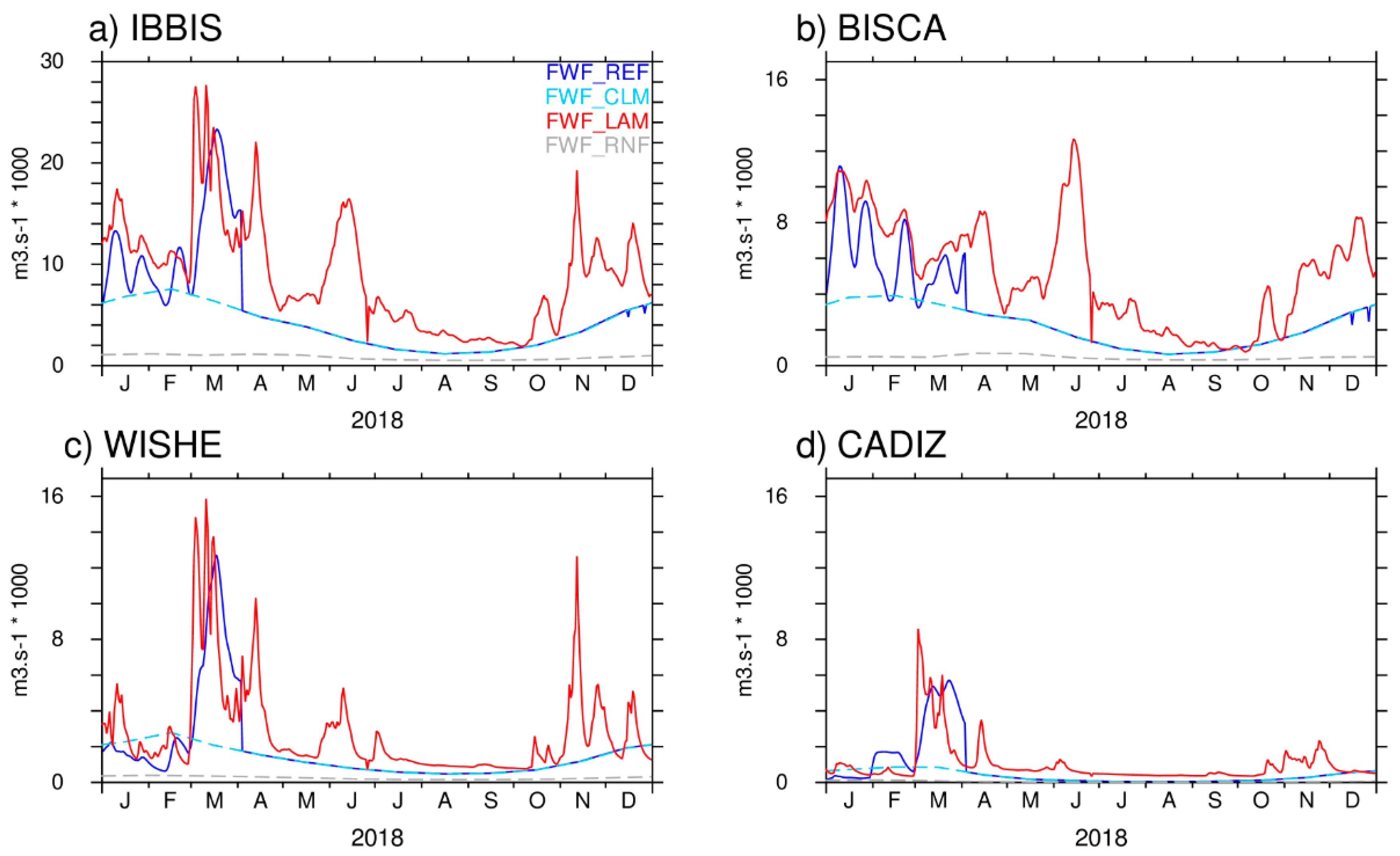
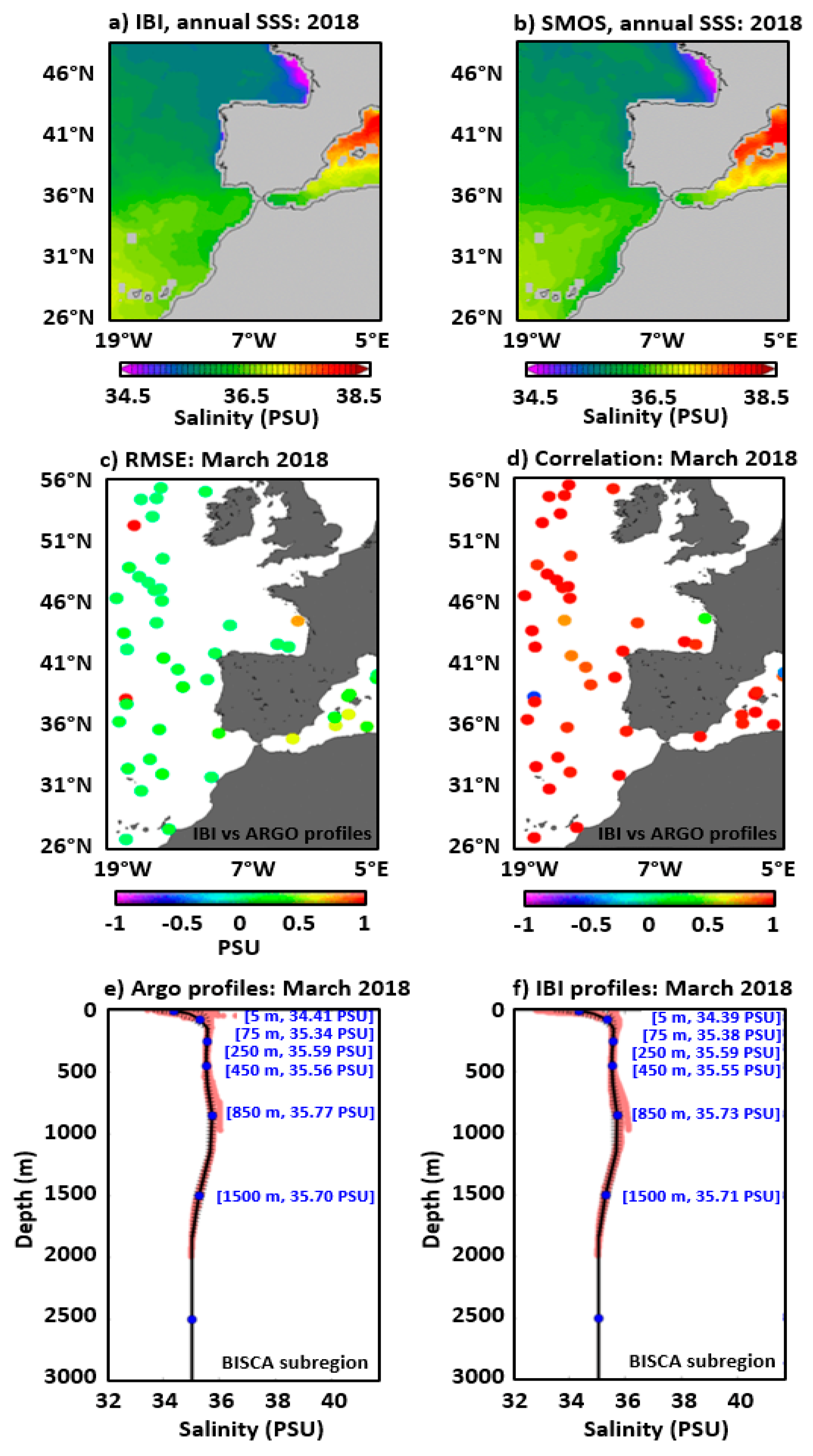
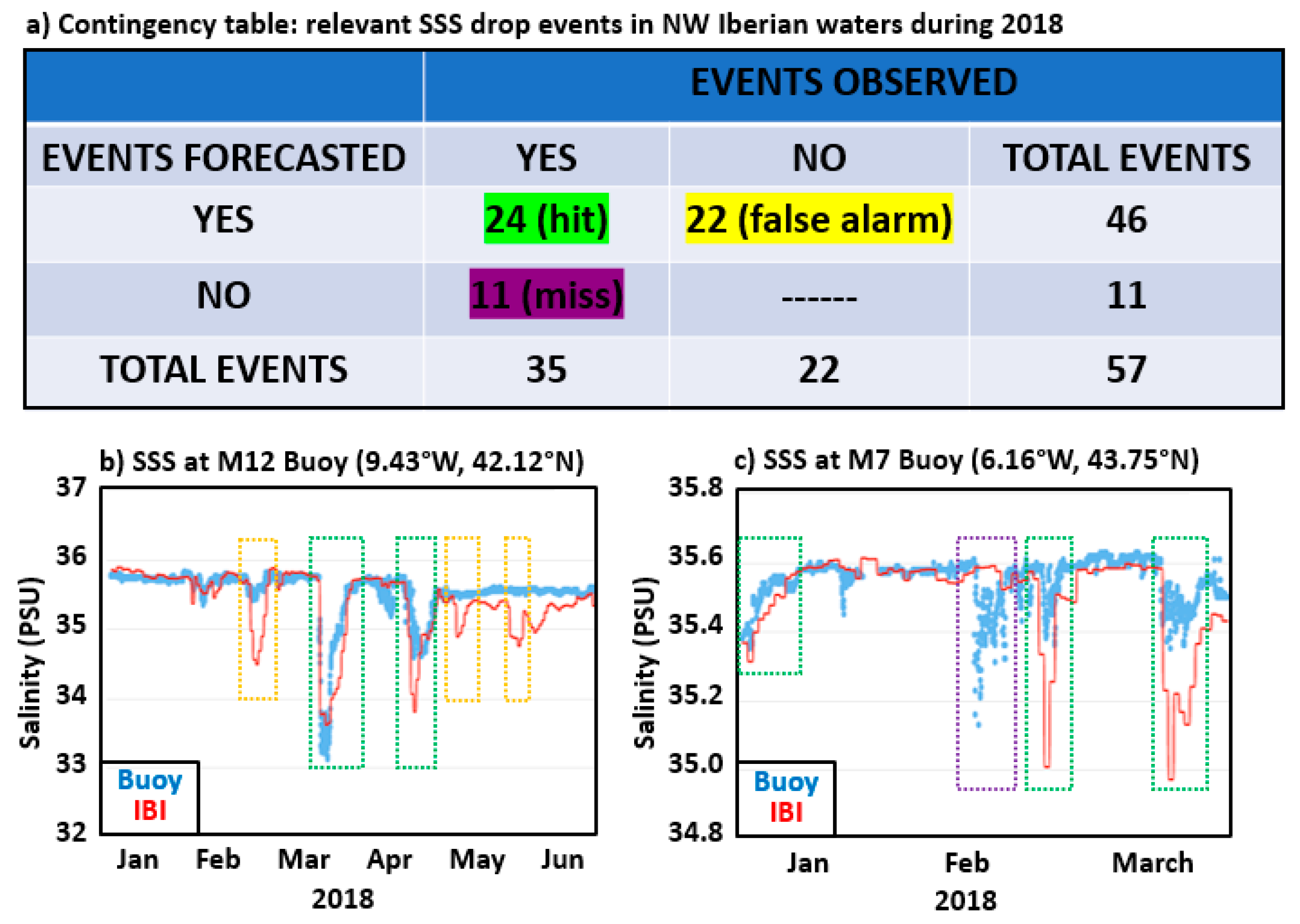
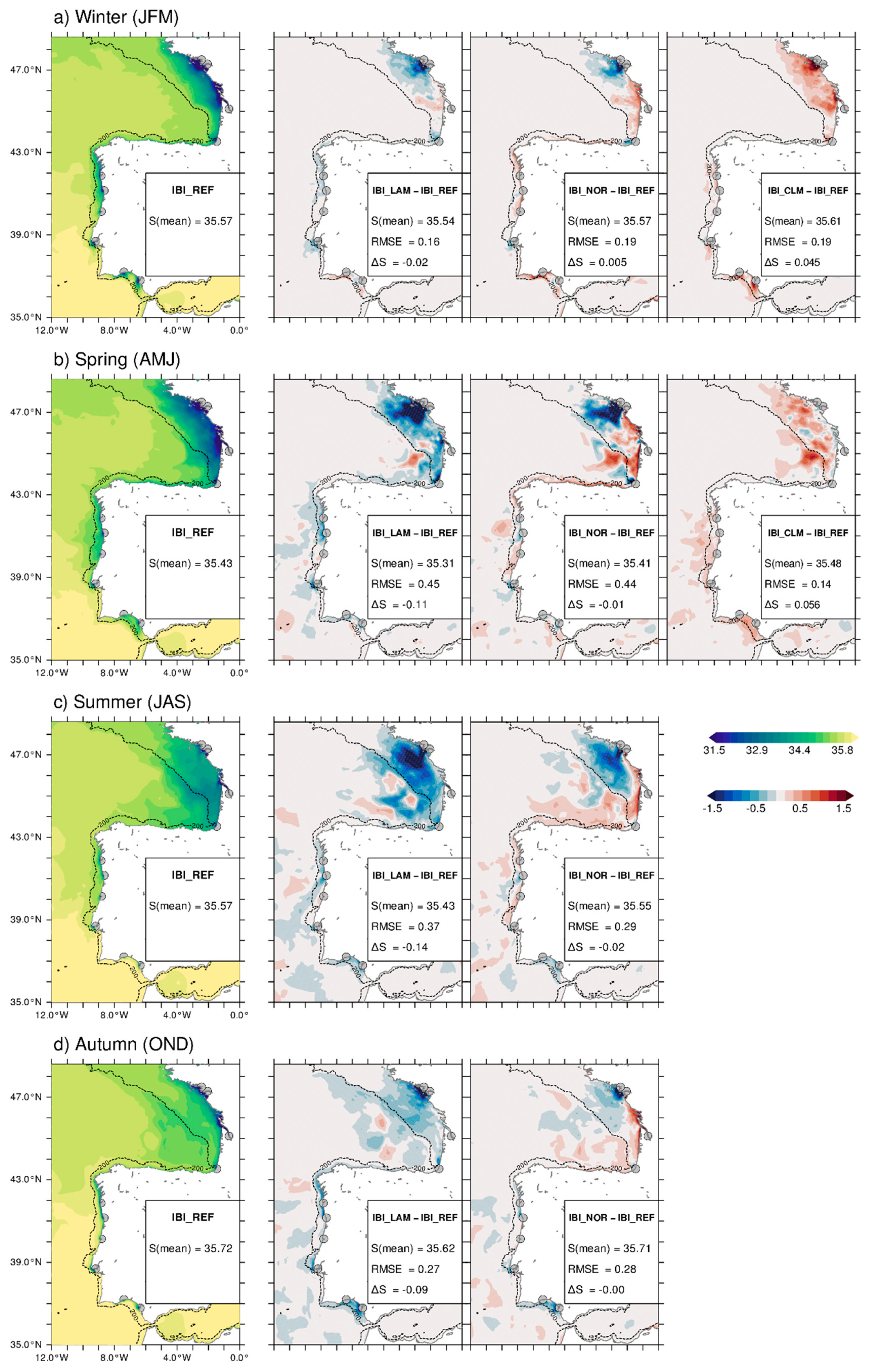
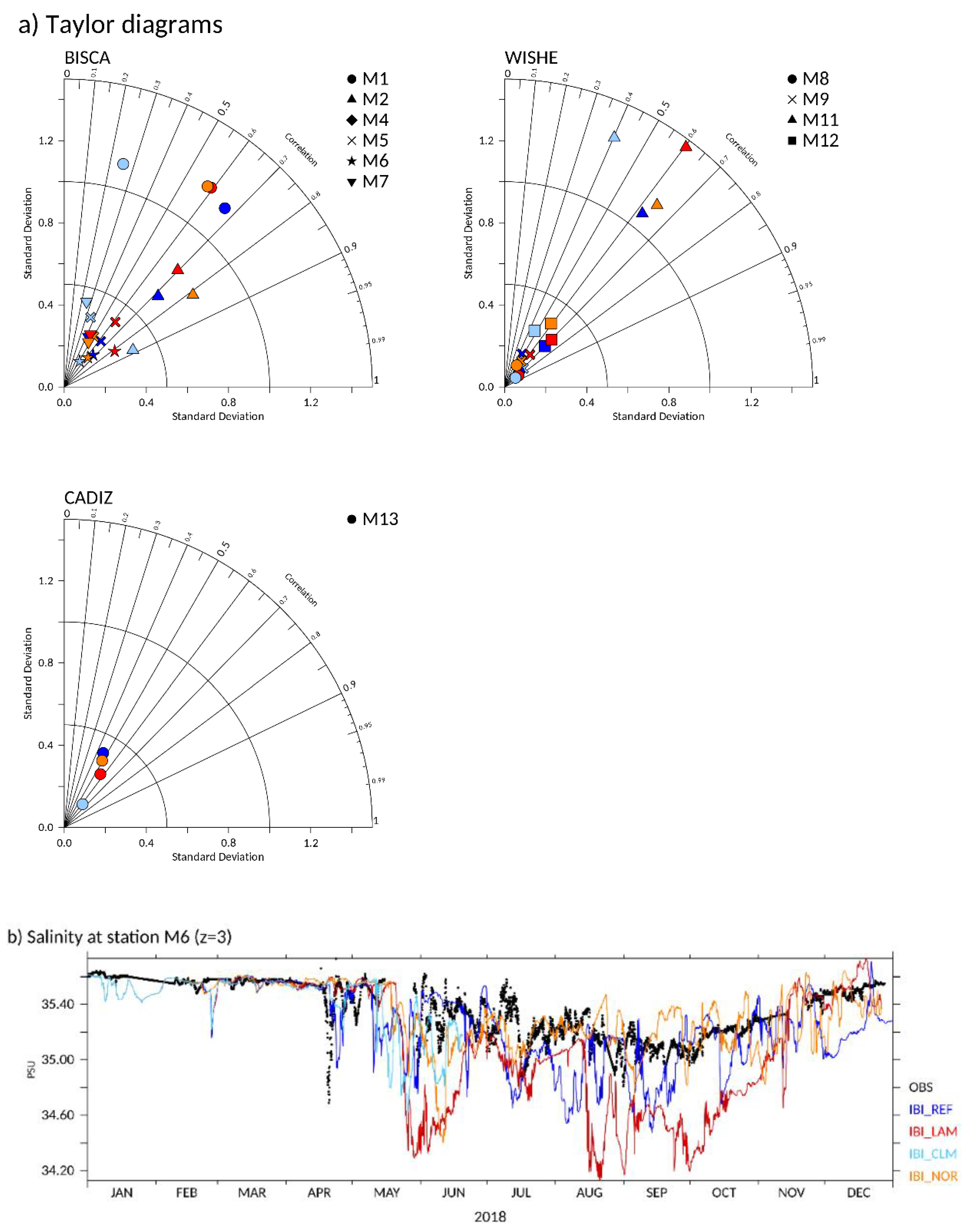
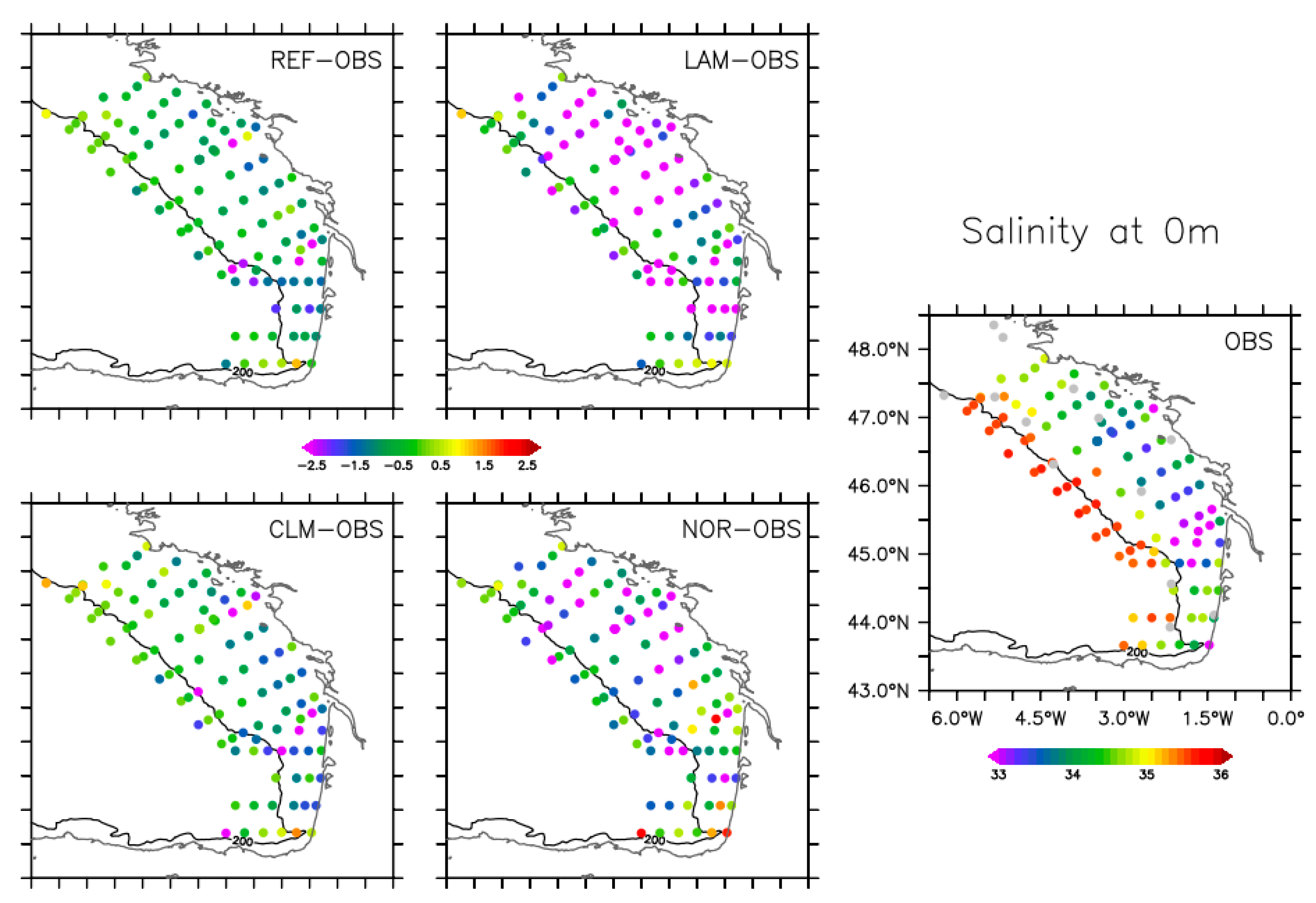


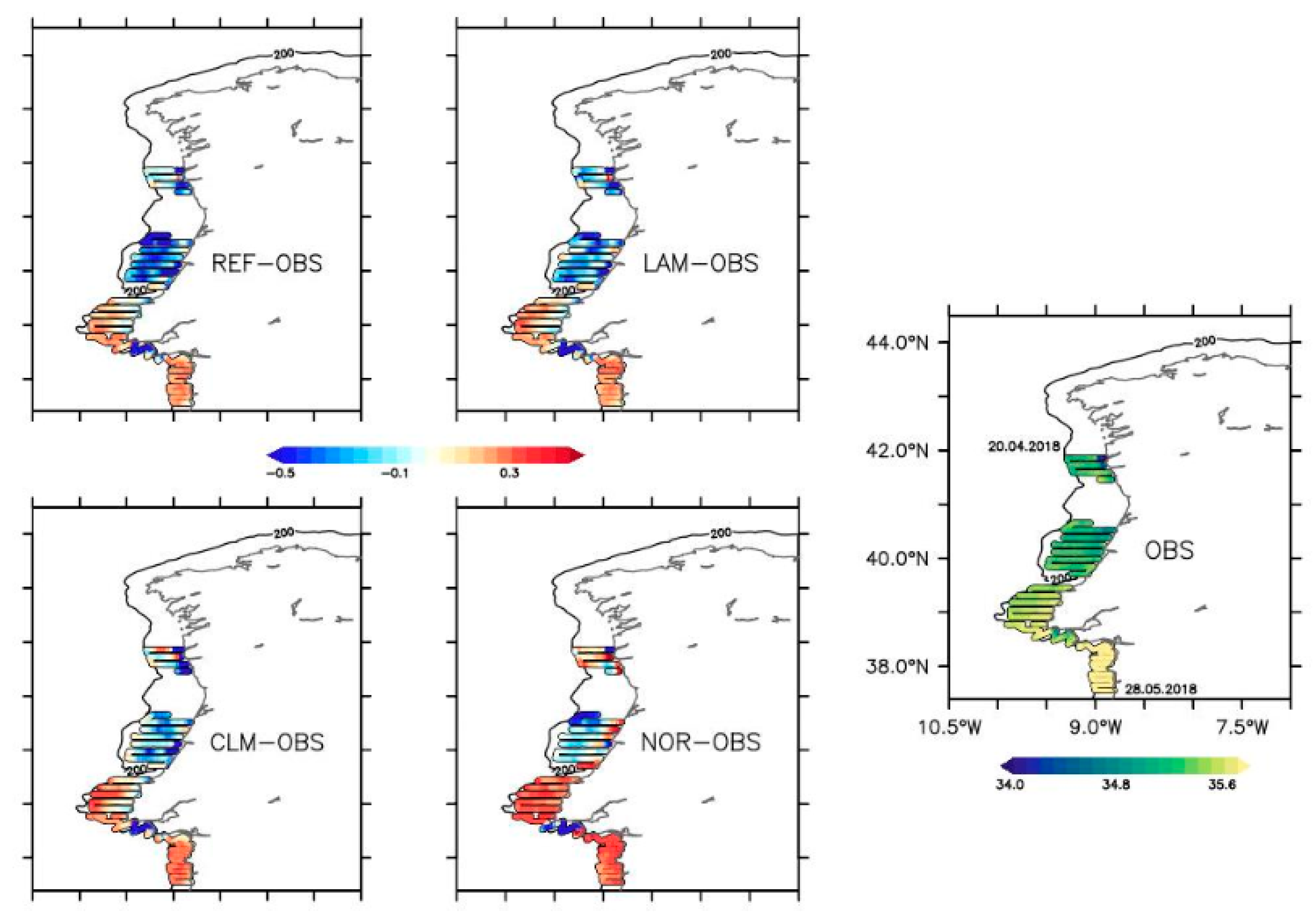
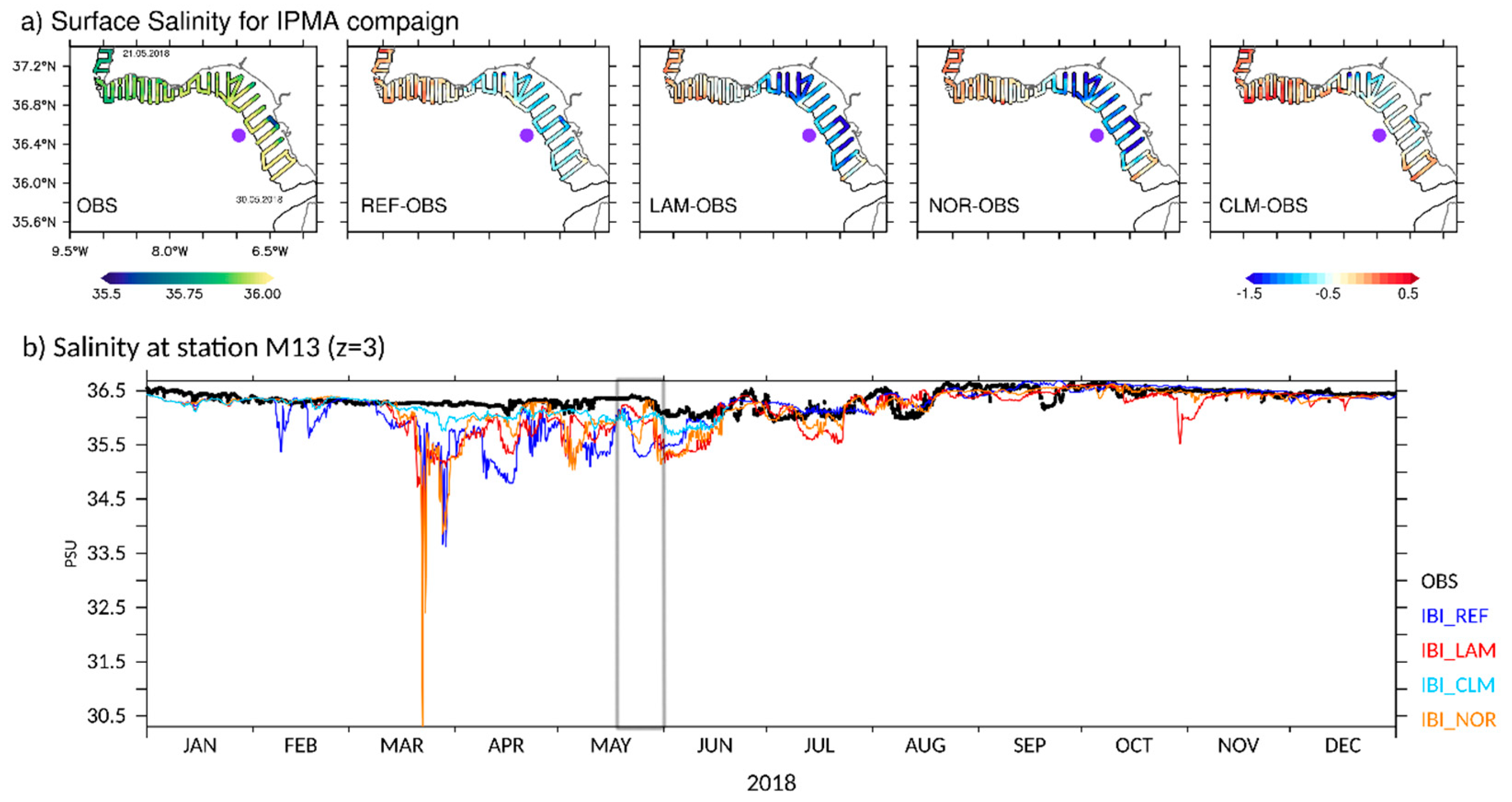
| Bay of Biscay (BISCA): 9.5 W–5.8 W/35.5 N–37.38 N | Western Iberian Shelf (WISHE): 10.5 W–7 W/37.4 N–44.5 N | Gulf of Cadiz (CADIZ): 10 W–6.5 W/43 N–48.5 N | Iberian-Biscay (IBBIS): 12 W–0 W/35 N–48.6 N | |
|---|---|---|---|---|
| Hourly SSS Timeseries at Mooring Buoy | 7 stations (M1 to M7, from N to S) | 5 stations (M8 to M12, from N to S) | 1 station (M13) | 13 stations (M1 to M13, from N to S) |
| (Shelf) XBT salinity profiles | 106 profiles | - | - | 106 profiles |
| Weekly (Coastal) CTD salinity profiles | - | 5 stations | - | 5 stations |
| Surface (Shelf) salinityTransects | - | 1 campaign (IPMA 28 April–20 May 2018) | 1 campaign (IPMA 21 May–30 May 2018) | 1 campaign (IPMA 28 April–30 May 2018) |
| Obs Source | Obs Type | Vertical Coverage | Geographical Coverage | Temporal Frequency | Purpose |
|---|---|---|---|---|---|
| Mooring Buoys | In-situ | Surface | Mostly on shelf | Hourly | Validation |
| SMOS | Remote sensed | Surface | IBI domain | Daily | Validation |
| Argo profilers | In-situ | 3-Dimensional | Open waters | Daily | Validation |
| Gliders | In-situ | 3-Dimensional | Ibiza Channel | Daily | Validation |
| Climatology * | Gridded product | 3-Dimensional | IBI domain | Monthly | Consistency |
| IBI Freshwater Discharge Forcing Data | Mean Daily (Cumulated) Freshwater Discharge in m3s−1 (in 103 m3s−1) | |||
|---|---|---|---|---|
| BISCA 1 | WISHE 2 | CADIZ 3 | IBBIS 1,2,3 | |
| FWF_REF (IBI_OP Reference Forcing) | 1031 (2826) | 624 (1709) | 251 (687) | 1906 (5223) |
| FWF_LAM (LAMBDA Forcing) | 1876 (5141) | 1017 (2787) | 358 (982) | 3252 (8910) |
| FWF_CLM (Climatology) | 806 (2207) | 486 (1330) | 130 (355) | 1421 (3893) |
| FWF_CRF (Coastal runoff climatology) | 6 (463) | 3 (261) | 1 (57) | 10 (843) |
| IBI Model Scenario | River Discharge Forcing | Use of Extra Coastal Runoff | IBI Model Run Type and Main Features |
|---|---|---|---|
| IBI_REF | FWF_REF | Yes | Free run (from 1 January 2018 to 31 December 2018). Control run. |
| IBI_LAM | FWF_LAM | Yes | Free run (from 1 January 2018 to 26 December 2018). LAMBDA river forcing scenario |
| IBI_NOR | FWF_LAM | No | Free run (from 1 January 2018 to 26 December 2018). LAMBDA river forcing, but no Coastal runoff |
| IBI_CLM | FWF_CLM | Yes | Free run (from 1 January 2018 to 19 June 2018). River climatological forcing scenario |
| IBI_OP | FWF_REF | Yes | CMEMS IBI Operational product (from 1 January 2018 to 31 December 2018) Data Assimilation scheme included (weekly update from IBI Analysis). Used as reference. |
| Salinity Observations in BISCA | RMSE | Bias (Model Observations) | ||||||||
|---|---|---|---|---|---|---|---|---|---|---|
| IBI_REF | IBI_LAM | IBI_CLM * | IBI_NOR | IBI_REF | IBI_LAM | IBI_CLM * | IBI_NOR | |||
| Mooring (2018) | Depth (m) | N | ||||||||
| M1 | 5 | 8314 | 1.18 | 1.21 | 1.35 | 1.54 | 0.16 | 0.04 | 0.75 | 0.97 |
| M2 | 1 | 3622 | 0.96 | 1.58 | 0.64 | 1.22 | −0.72 | −1.36 | −0.52 | −0.94 |
| M3 | 1 | 6633 | 2.68 | 2.63 | 2.47 | 3.71 | 1.28 | 1.14 | 1.33 | 2.88 |
| M4 | 10 | 2701 | 0.78 | 1.18 | 0.91 | 1.59 | −0.65 | −0.92 | −0.69 | −1.12 |
| M5 | 3 | 6938 | 0.31 | 0.49 | 0.39 | 0.28 | −0.11 | −0.28 | −0.13 | 0.00 |
| M6 | 3 | 8160 | 0.24 | 0.38 | 0.15 | 0.19 | −0.11 | −0.24 | −0.04 | −0.03 |
| M7 | 3 | 7022 | 0.32 | 0.30 | 0.48 | 0.38 | 0.18 | 0.11 | 0.22 | 0.29 |
| RECOPESCA (May 2018) | Depth (m) | N | ||||||||
| 0 | 106 | 1.69 | 2.14 | 1.55 | 1.79 | −0.76 | −1.24 | −0.52 | −0.79 | |
| 5 | 106 | 0.99 | 1.39 | 0.74 | 1.14 | −0.67 | −1.03 | −0.39 | −0.71 | |
| 10 | 106 | 0.47 | 0.61 | 0.46 | 0.56 | −0.21 | −0.32 | −0.03 | −0.21 | |
| 20 | 106 | 0.38 | 0.43 | 0.28 | 0.39 | −0.20 | −0.25 | −0.10 | −0.19 | |
| 50 | 106 | 0.11 | 0.09 | 0.09 | 0.09 | −0.06 | −0.06 | −0.05 | −0.04 | |
| Salinity Observations in WISHE | RMSE | Bias (Model Observations) | ||||||||
|---|---|---|---|---|---|---|---|---|---|---|
| IBI_REF | IBI_LAM | IBI_CLM * | IBI_NOR | IBI_REF | IBI_LAM | IBI_CLM * | IBI_NOR | |||
| Moorings (2018) | Depth (m) | N | ||||||||
| M8 | 3 | 8587 | 0.16 | 0.13 | 0.09 | 0.19 | 0.12 | 0.10 | 0.06 | 0.15 |
| M9 | 3 | 8676 | 0.19 | 0.20 | 0.13 | 0.17 | 0.06 | 0.03 | –0.01 | 0.08 |
| M10 | 3 | 6981 | 13.1 | 13.0 | 17.7 | 13.48 | 9.2 | 8.9 | 14.0 | 9.62 |
| M11 | 9 | 6835 | 1.43 | 1.99 | 1.64 | 1.19 | −0.93 | −1.35 | −0.96 | −0.24 |
| M12 | 3 | 8701 | 0.28 | 0.34 | 0.91 | 0.38 | −0.03 | −0.10 | −0.05 | −0.01 |
| IPMA | Depth (m) | N | ||||||||
| surface | 1563 | 0.51 | 0.73 | 0.50 | 0.64 | −0.14 | −0.18 | −0.06 | 0.01 | |
| INTECMAR | N | |||||||||
| C1 | 41 | 0.35 | 0.45 | 0.47 | 0.32 | 0.15 | 0.25 | 0.20 | 0.02 | |
| C2 | 38 | 0.50 | 0.62 | 0.78 | 0.48 | 0.14 | 0.26 | 0.17 | 0.03 | |
| C3 | 48 | 0.36 | 0.51 | 0.55 | 0.43 | −0.06 | 0.07 | −0.14 | −0.04 | |
| C4 | 45 | 0.39 | 0.53 | 0.45 | 0.38 | 0.05 | 0.14 | 0.07 | −0.01 | |
| C5 | 45 | 0.48 | 0.66 | 0.59 | 0.51 | 0.10 | 0.21 | 0.09 | 0.04 | |
| Salinity Observations in CADIZ | RMSE | Bias (Model Observations) | ||||||||
|---|---|---|---|---|---|---|---|---|---|---|
| IBI_REF | IBI_LAM | IBI_CLM * | IBI_NOR | IBI_REF | IBI_LAM | IBI_CLM * | IBI_NOR | |||
| Mooring (2018) | Depth (m) | N | ||||||||
| M13 | 3 | 8587 | 0.45 | 0.37 | 0.21 | 0.41 | −0.19 | −0.20 | −0.15 | −0.17 |
| IPMA (May 2018) | surface | 1217 | 0.59 | 1.18 | 0.42 | 1.12 | −0.50 | −0.87 | −0.28 | −0.71 |
Publisher’s Note: MDPI stays neutral with regard to jurisdictional claims in published maps and institutional affiliations. |
© 2021 by the authors. Licensee MDPI, Basel, Switzerland. This article is an open access article distributed under the terms and conditions of the Creative Commons Attribution (CC BY) license (https://creativecommons.org/licenses/by/4.0/).
Share and Cite
Sotillo, M.G.; Campuzano, F.; Guihou, K.; Lorente, P.; Olmedo, E.; Matulka, A.; Santos, F.; Amo-Baladrón, M.A.; Novellino, A. River Freshwater Contribution in Operational Ocean Models along the European Atlantic Façade: Impact of a New River Discharge Forcing Data on the CMEMS IBI Regional Model Solution. J. Mar. Sci. Eng. 2021, 9, 401. https://doi.org/10.3390/jmse9040401
Sotillo MG, Campuzano F, Guihou K, Lorente P, Olmedo E, Matulka A, Santos F, Amo-Baladrón MA, Novellino A. River Freshwater Contribution in Operational Ocean Models along the European Atlantic Façade: Impact of a New River Discharge Forcing Data on the CMEMS IBI Regional Model Solution. Journal of Marine Science and Engineering. 2021; 9(4):401. https://doi.org/10.3390/jmse9040401
Chicago/Turabian StyleSotillo, Marcos G., Francisco Campuzano, Karen Guihou, Pablo Lorente, Estrella Olmedo, Ania Matulka, Flavio Santos, María Aránzazu Amo-Baladrón, and Antonio Novellino. 2021. "River Freshwater Contribution in Operational Ocean Models along the European Atlantic Façade: Impact of a New River Discharge Forcing Data on the CMEMS IBI Regional Model Solution" Journal of Marine Science and Engineering 9, no. 4: 401. https://doi.org/10.3390/jmse9040401
APA StyleSotillo, M. G., Campuzano, F., Guihou, K., Lorente, P., Olmedo, E., Matulka, A., Santos, F., Amo-Baladrón, M. A., & Novellino, A. (2021). River Freshwater Contribution in Operational Ocean Models along the European Atlantic Façade: Impact of a New River Discharge Forcing Data on the CMEMS IBI Regional Model Solution. Journal of Marine Science and Engineering, 9(4), 401. https://doi.org/10.3390/jmse9040401







